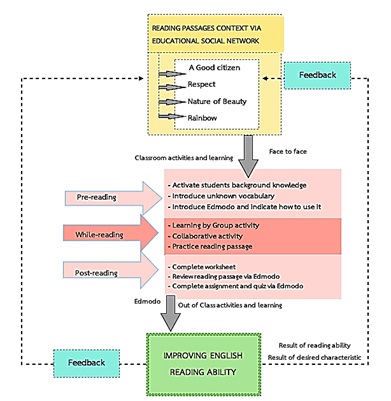USING AN EDUCATIONAL SPACE ON SOCIAL NETWORKING TO PROMOTE EXTENSIVE READING OF UPPER ELEMENTARY STUDENTS
DOI:
https://doi.org/10.14456/nrru-rdi.2020.63Keywords:
Extensive reading, Elementary students, English program, Upper elementaryAbstract
A strong medium has tremendously efforts on various aspects of educational area, since educational space on social networking can create an online meeting point for teachers and students. Thus, the study examines how the use of Edmodo relates to the reading skill of 4th-6th grades or upper primary level students in a Catholic private school in Nakhon Ratchasima province. Students’ English reading skill in Primary Education level is essential, especially for the courses of Sciences and Social Studies, and is commonly utilized in under English Program’s curriculum, Primary Education. Edmodo is selected to promote students’ ability as an Extensive Reading (ER). Forty-two students of 4th-6th grades were selected by cluster sampling in studying four reading passages which is under their syllabuses. The findings show that students had benefited from ER. Questionnaire results show that students’ reading habits had improved significantly. The reports from the interviews show that students’ affective, including reading speed, had also improved. In addition, students answered pre-and post-reading questionnaires on their reading habits. Students were selected based on their performance in a reading through Edmodo and interviewed to gain more insight into their reading experiences. The questionnaires were analyzed using the t-test, and the interview responses were analyzed by content analysis, which showed that students were effectively satisfied with using Edmodo in enhancing their extensive reading skill.
References
Al-Awidi, H. M., & Ismail, S. A. (2014). Teachers’ perceptions of the use of computer assisted language learning to develop children’s reading skills in English as a second language in the United Arab Emirates. Early Childhood Education Journal, 42(1), 29-37.
Cankaya, S., Durak, G., & Yunkul, E. (2013) Using Educational Social Networking Sites in Higher Education: Edmodo through the Lenses of Undergraduate Students. European. Journal of Educational Technology 1(1), 3-23. Retrieved May 1, 2014, from http://www.ejetech.eu/images/form/ dosya/dosya_224911.pdf
Cruz, M. B., & Cruz, S. B. (2013) The Use of Internet-Based Social Media as a Tool in Enhancing Student’s Learning Experiences in Biological Sciences. Higher Learning Research Communications, 3(4), 68-80.
Retrieved May 1, 2014, from http://journals.sfu.ca/liu/index.php/HLRC/article/view/170
Day, R. R., & Bamford, J. (2009). ER in the second language classroom. Cambridge : Cambridge University Press.
Elliot, D. (2009). Internet Technologies and Language Teacher Education. Handbook of research on Web 2.0 and second language learning (pp. 432-450).
Faircloth, G. (2009). A Qualitative study/counter-story telling: A Counter-Narrative of Liter acy Education for African Americam Males. doctoral dissertation. Miami University.
Fleishman, E. B. (2008). Adolescent literacy: A national reading crisis. Scholastic Professional Paper. https://www.scholastic.com/dodea/pdfs/Paper_Literacy_Crisis.pdf
Gaber-Katz, E. (1999). The use of story in critical literacy practice. Gender & Education, 8(1), 49-60.
Grabe, W. (1997). TeachingL2reading: Moving from theory to practice. Paper presented at TESOL Academy, Seattle University.
Grabe, W. (2009). Reading in a second language: Moving from theory to practice (2nd ed.). Cambridge : Cambridge University Press.
Grabe, W., & Stoller, F. L. (2011). Teaching and Researching Reading. Harlow : Pearson.
Hoody, M. L. (2008). Critical Literacy in Primary Education: Policy, Praxis and the Postmodern. Dissertation, Doctor of Education, University of Minnesota.
Horst, M. (2005). ‘Learning second language vocabulary through ER: A measurement study’. The Canadian Modern Language Review 61, 355-382. https://doi.org/10.3138/cmlr.61.3.355
Hourdequin, P. (2014). Edmodo: A Simple Tool for Blended Learning. The Language Teacher, 38(1), 34-46.
Retrieved May 22, 2019, from http://jalt-publications.org/tlt/departments/ tlt-wired/articles/3547-edmodo- simple-tool-blended-learning
Kongchan, C. (2008). How a non-digital-native teacher makes use of edmodo. In 5th Intenational Conference ICT for Language Learning. Florence.
Krashen, S. D. (2004). ‘Free voluntary reading: New research, applications, and controver. sies’. Paper presented at the RELC Conference, Singapore. April, Retrieved September 11, 2019, from http:// www.sdkrashen.com/content/articles/singapore.pdf
Looi, C. Y., & Yusop, F. D. (2011) Potential Use of Social Networking Tool to Assist Reading Comprehension: Implications for Practice and Future Research. Jurnal Pendidikad, 31(1), 189-201. Retrieved May 1, 2018, from http://www.academia.edu/3718356/Potential_use_of_social_networking_tool_to_assistreading_comprehension_implications_for_practice_and_future_research
Maureen, I. Y., van der Meij, H., & de Jong, T. (2018). Supporting literacy and digital literacy development in early childhood education using storytelling activities. International, Journal of Early Child hood, 50(3), 371-389.
Nordin, N., Embi, M. A., & Yunus, M. M. (2010). Mobile learning framework for lifelong learning. Procedia-Social and Behavioral Sciences, 7, 130-138.
Phipps, R., & Merisotis, J. (1999). What’s the Difference? A Review of Contemporary Re search on the Effectiveness of Distance Learning in Higher Education. Washington, DC : The Institute for Higher Education Policy.
Safaeia, L. A., & Bulca, M. (2013). ‘ER and creative practices’, Retrieved July 30, 2019, from http://www. sciencedirect.com/science/article/pii/S1877042813000980#
Scott, L., & Saaiman, E. (2016). ‘Promoting reading skills or wasting time? Students’ perceived benefits of reading in an intermediary programme at the Vaal University of Technology. Reading & Writing, 7(1), 1-11. https://doi.org/10.4102/rw.v7i1.82
Yamashita, J. (2004). ‘Reading attitudes in L1 and L2, and their influence on L2 ER’. Reading in a Foreign Language 16(1), Retrieved June 18, 2018, from https://www.researchgate.net/publication/239934894_Reading_Attitudes_in_L1_and_L2_and_Their_Influence_on_L2_Extensive_Reading





